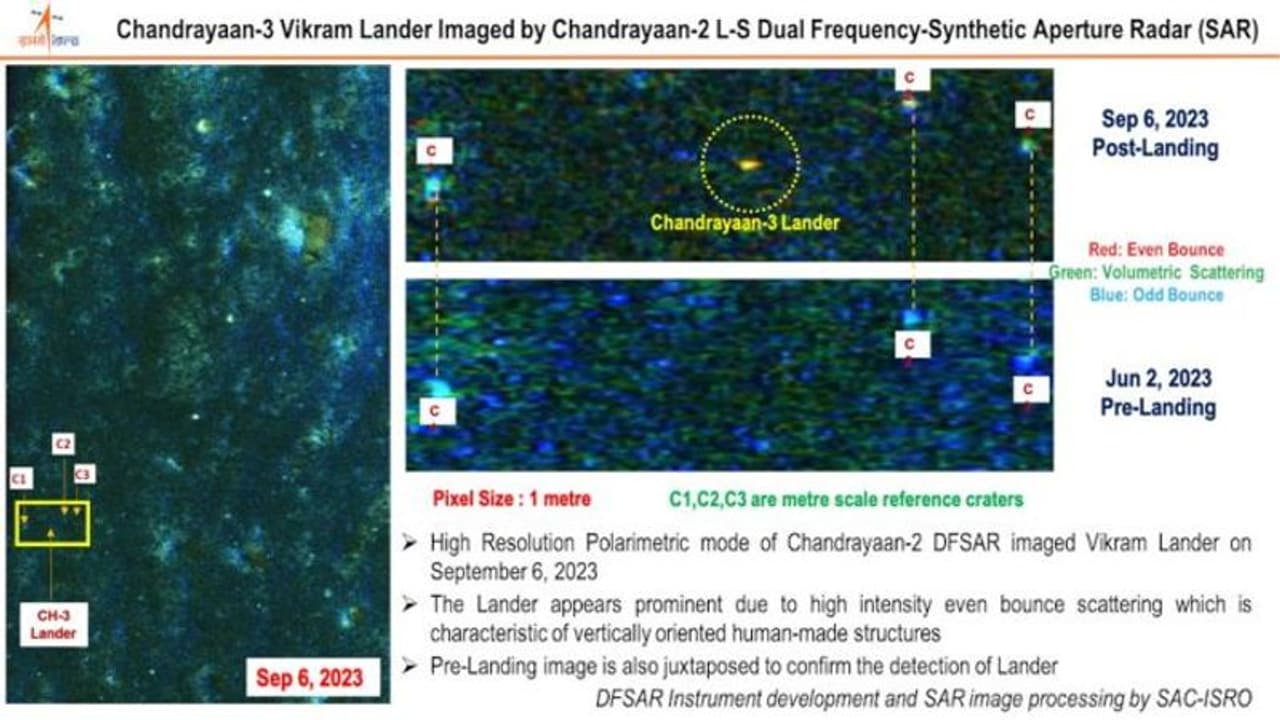The Chandrayaan-2 orbiter, armed with the Dual-frequency Synthetic Aperture Radar (DFSAR), is providing a unique view of the lunar surface, even during the moon's dark nights. Girish Linganna explains how this radar instrument, operational since 2019, works
The Vikram lander was recently seen from a fresh perspective on the lunar surface, courtesy of a crucial instrument on the Chandrayaan-2 orbiter, capable of capturing images without relying on sunlight. This recent capture during the lunar night occurred shortly after the Indian Space Research Organisation (ISRO) unveiled a distinctive "anaglyph" image of the lander, offering a three-dimensional experience when viewed through compatible lenses.

On Wednesday, September 6, the dual-frequency synthetic aperture radar (DFSAR) instrument aboard India's lunar orbiter, in operation since 2019, captured an image of the Chandrayaan-3 lander. A potent remote sensing device, the synthetic aperture radar (SAR) is a method for generating images utilizing radio waves.
DFSAR: Unveiling Planetary Secrets
Dual-frequency Synthetic Aperture Radar (DFSAR) is a radar instrument that operates at two different frequencies, typically L-band (20-30 GHz) and S-band (2-4 GHz). This allows it to image the surface of objects, such as the Moon, in greater detail than a single-frequency radar.
As DFSAR operates on radar technology, it can capture images independently of sunlight. This allowed for imaging of the Vikram lander during the lunar night.
DFSAR works by emitting a radar pulse and then receiving the echo from the surface. The time it takes for the echo to return tells the distance to the surface. The strength of the echo tells the radar about the roughness of the surface.
By operating at two different frequencies, DFSAR can distinguish between different types of materials on the surface. For example, water has a different radar signature than rock. This allows DFSAR to map the distribution of water on the Moon, which is important for understanding the Moon's geology and habitability.
DFSAR is also used to study the Moon's subsurface. The longer radar wavelength at the L-band can penetrate deeper into the surface than the shorter radar wavelength at the S-band. This allows DFSAR to image features that are buried beneath the surface, such as lava tubes and ice deposits.
DFSAR is a powerful tool for studying the Moon and other planetary bodies. It is used by scientists to map the surface, study the subsurface, and search for water and other resources.
Some advantages of the DFSAR
DFSAR can image the surface of objects in greater detail than a single-frequency radar. It can distinguish between different types of materials on the surface. It can image features that are buried beneath the surface. It is a lightweight and compact instrument that can be easily deployed on spacecraft.
DFSAR is a valuable tool for planetary exploration and has been used on a number of missions, including Chandrayaan-2, Mars Reconnaissance Orbiter, and OSIRIS-REx. It is expected to play an important role in future missions to the Moon and other planets. For the past four years, DFSAR has been diligently scanning the lunar surface, with a primary emphasis on lunar polar science, and transmitting valuable data back to Earth.
Previously, ISRO shared an image of the landing site, which included the Vikram lander, captured by the high-resolution camera (OHRC) aboard the Chandrayaan-2 orbiter. Before the momentous lunar landing, a two-way communication link had been established between the Chandrayaan-2 orbiter and the Chandrayaan-3 lander module.
